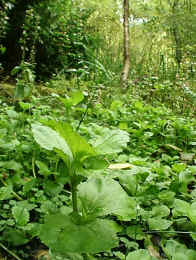Plant Adaptations to Aquatic Life -
continued
 |
Marsh Plants are characterised by luxuriant growth and often have large leaves. Close to the water's edge, there is no shortage of water for growth. Plants in this region can therefore afford to have large leaves since excessive loss of moisture from the foliage is not a problem. However, because the soil is generally water logged, it tends to be also anaerobic and short of oxygen. Plants in this zone therefore often have large air spaces within their internal structure to store air, in case of shortages in the soil.
Offwell Wetland Marsh Species List

A brief discussion of the adaptations needed by terrestrial plants is included here in order to provide a different perspective on the adaptations of aquatic plants.
Terrestrial plants have a different set of problems to hydrophytes (aquatic plants). There are two main problems for terrestrial plants. The first is the requirement for mechanical support, because air will not hold up plant structures in the same way that water does. In the extraordinarily competitive struggle for light within plant communities, great advantages are conferred by being tall. However, as any engineer will tell you, the taller a structure is, the deeper the foundations need to be and the greater the mechanical support needed to hold it up.
In order for plants to become tall they must have good strengthening structures in their stems and branches. They also need an extensive root system to anchor them solidly in the ground. Trees are a prime example of this with their great development of woody material in trunks and branches and highly developed root systems.
The second main problem of terrestrial plants is water conservation. Unlike freshwater aquatic plants which have no water constraints, terrestrial plants may have trouble obtaining enough water from the soil in the first place. Once they have obtained the water (here, an extensive, or deep root system is again of value), they must then be able to retain it for long enough to utilise it. Land plants therefore have some sort of cuticle or protective layer developed on the external surfaces to prevent water loss.
As with all living things, plants must also take in oxygen and give out carbon dioxide as they respire. Additionally, they take in carbon dioxide from the atmosphere for photosynthesis and give out oxygen as a by-product. Because the external surfaces are covered with an impermeable protective layer, these gas exchanges have to take place through specialised breathing pores (stomata). In order to exchange gases the stomata must remain open. The downside of this is that as long as they are open, water can be lost through them as water vapour (transpiration). Terrestrial plants have developed many adaptations to overcome this problem, including wilting when water is short, which immediately closes the stomata.
Back to Aquatic plant adaptations page 1